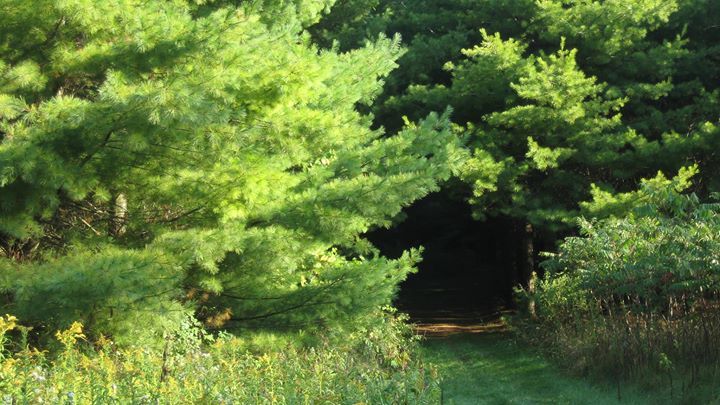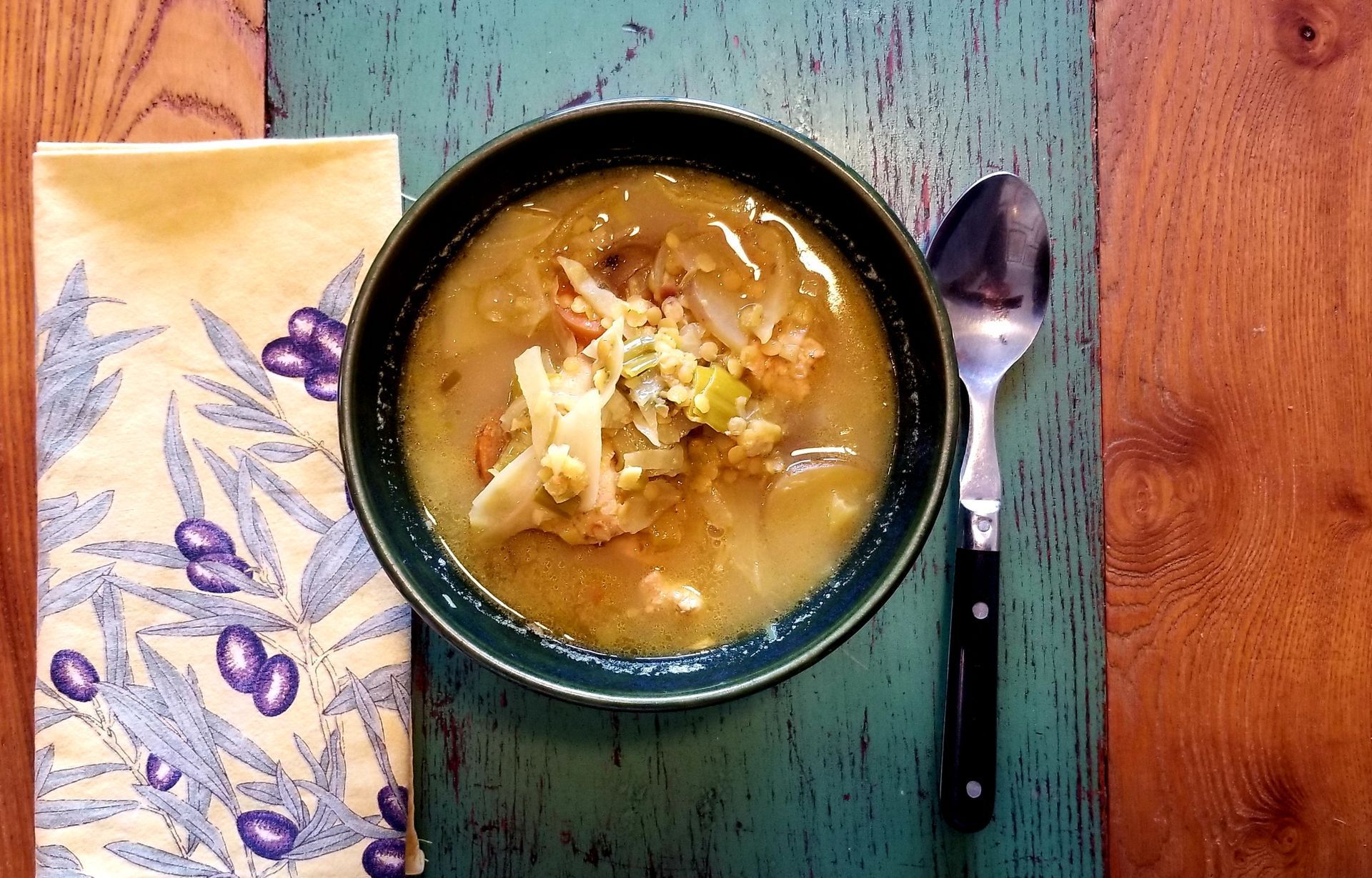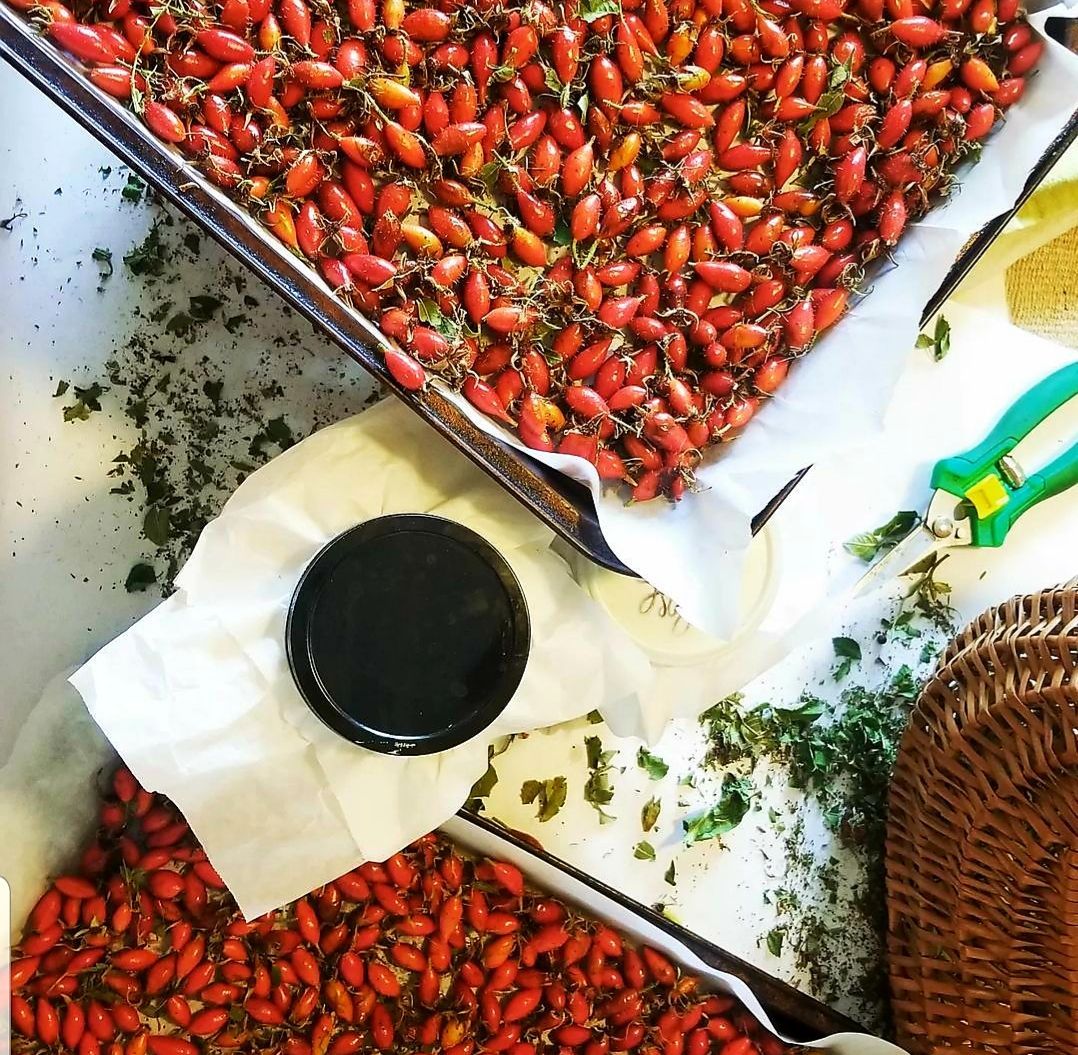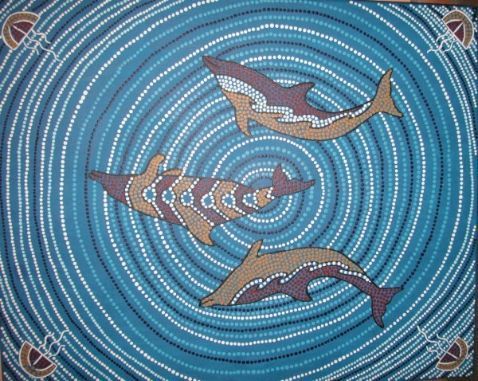Blog
Alchemy for the Mind, Body and Being

By Andrée Beauchamp
•
11 Jan, 2023
While preparing for purple belt level with the Toronto Academy of Karate some years ago, I practiced Matsukazi continuously until it became one finite movement. I became both strong and flexible. Matsukazi, is a Japanese word, meaning wind in the pines, and points directly at the strength and flexibility of the pine tree. What better time to become familiar with the healing prowess of the pine than now. Wander in the forests near you to find the white pine groves of Pinus Strobus, the eastern white pines of Ontario to gather the fresh needles, the cones, cambium, the pollen, and to collect the resin. Ultimately stop and rest to revive on the floor of the pine needles. Pine trees emit numerous compounds that have healing benefits for the mind, body and soul. These compounds are beneficial to man, animals, fungus and insects alike. There are approximately 115 different species of pine worldwide - 36 of which grow in North America. These evergreen and resinous coniferous trees (in the family Pinus , and the genus Pinaceae ), native to most of the Northern Hemisphere. There are actually two groups of pines, softwood pines and hardwood pines. There is one sure way to identify the white pine by the number of needles it has, with clusters of five needles per leaf up to 18 inches long. The hard pines are bristly and have three needles per cluster. Canada boasts nine of these species of the pine tree; including the eastern white pine, P. Strobus, western white pine P. monoticola, limber pine, P. flexilis, white bark pine P. albicaulis, ponderosa pine, P. ponderosa, pitch pine, P. rigida, red pine, P. resinosa, jack pine P. banksiana, and the lodgepine, P. contorta. The scotch pine which many will recognise, P. sylvestris with its bristly attire, is the pine my family chose to grace our home at Christmas in the west; a nonnative pine and incidentally the most planted and most studied pine in the world. The trees of N. America were cherished by the Native Americans. The Pine was considered first and foremost for healing and medicine, says Diana Beresford Kroeger in her book The Arboretum America. The pine was as important to the ancient Turks as it was to the Balkans, to the Chinese or to the ancient Scots peoples. One can find references for the use and medicines for pine since the beginning of time. Pines will survive in extreme heat, drought and elevation therefore the reason pines have a superior medicine. Historically pines are the source of many essential oils and substances made with them, such as pine oil, pine tar, and turpentine. Pine is also the source of pinene, which is used in the manufacture of camphor, insecticides, solvents, plasticizers, the base of perfumes and synthetic pine oil. Pine is also a source of an antibiotic and fungicide called pinosylvin. The Oneida peoples would smolder white pine needles in a bucket to fumigate their homes in the Spring and Fall to reduce the chances of illness through the season. The pine knots have been known for thousands of years on both sides of the Atlantic. The Romans used these pine knots as night lights which also provided an antiseptic and antibiotic action while burning. The pine knot says Kroeger contains the highest content of the antibiotic pinosylvin. When exposed to pine they exert a dilatory or opening action on the bronchi of the lungs hence why the pine has always been considered an important treatment for respiratory infections. In the winter the Onondaga peoples used the pine bark and needles to make a steam that was inhaled to reduce respiratory infections. A pine resin was also prepared using tallow and beeswax to which honey was added. This was made into a lollypop and the rest was saved for the treatment of cuts and wounds. White pine, P. strobus was also used to purify, and was burned and left to filter through a home to aid those who have lost loved ones and when a household member had returned after a long time. Did you know the pine is also associated with at least 53 different fungi many of which are edible making pine woods a feast in the fall. This means that underground the pine associates in a special way with an extraordinary diversity of fungal life. The fabulous fungi not only help trees to mount a defense against invading insects, shares Peter Wohlleben, the fungi network greatly increases a tree’s functional root surface so that it can absorb a great deal more water and nutrients. The needles and the inner bark are available year round, while the cones of some pine are laden with edible nuts. These are gathered in the late summer, and the pine pollen is collected in the spring. The sap is collected in the fall and early winter. Along with viable traces of vitamins A, E, and a host of B vitamins, the cherished needles have been studied extensively. According to numerous articles the amount of vitamin C found in the fresh pine needles could be up to five times the amount found in citrus fruits. This means that a cup of pine needles may yield as much as 400 mg of Vitamin C per cup of brew. Vitamin C is a powerful antioxidant, a vital factor of the immune system. It also improves cardiovascular function, improves skin and eye health and is involved in collagen formation. In the warm weather, pine groves release terpenes and other volatile oils such as limonene as well as a variety of hydrophobic compounds which have been found to be most useful with respiratory infections, being expectorant, antitussive, anti inflammatory, ant ulcerative and muscle relaxant. Why not plant a grove of white pine in your neighborhood for all to enjoy. Diana believes that hospital settings and healing centers would benefit with a grove of pines on the grounds to aid all those with mental health and respiratory conditions. The cambium of the pine (between the bark and the wood) can be boiled or roasted as a famine food, and made into a flour. Everyone has had a pine nut or two. Animals like the pine nuts as well, including squirrels, turkey, quail, and brown-headed nuthatches. Some 20 species of pines have nuts big enough to harvest for human food. Female pine cones can weigh up to 10 pounds and be two feet long which carry the nuts. Collect the female cones and place them near a source of heat to make them open and release the seeds. The pinyon pine Pinus edulis, the only pine with one needle per twig. produces the large, oily and sweet and nutritious pine nut that we most commonly see in the grocery stores and often used in making a pesto. Like the cambium, says Green Deane, the young male pine cones can be boiled and eaten. What is a male pine cone? They are small, soft and papery, whereas the female cones are big, woody and tough. Male cones are really not cones. Technically they are the pine pollen, “ microsporangia strobili'' which has over 200 identifiable elements from vitamins to hormones. They contain natural testosterone. It has about 27 nanograms per 0.1 grams of dry weight, not suitable for bulking up weightlifters, but available nonetheless. Putting the pollen under the tongue keeps it from being destroyed by the digestive system. Androstenedione is an adrenal hormone produced in humans. Reduce androstenedione by one molecule and you have testosterone, which both men and women have in different amounts. Androstenedione can raise testosterone levels. The effect lasts about a day. The Native Americans used it for extra energy when they needed it. So when on the run, grab a little pine pollen. Collect the pine pollen and sift it out with a fine mesh into a bowl to store away as needed. Another key compound found in pine is the Shikimic acid. The drug Tamiflu is made from the seed pods of the Chinese star anise tree which is found to have approx: 7% shikimic acid. Researchers have found that white pine needles contain about 3% shikimic acid and therefore a viable remedy when treating the flu. Did you know the pine resin is a component of Propolis, a mixture of tree saps and nectar from the flowers collected by the bees. You can watch the bees tearing the resin of a pine tree which can take up to an hour to load. They mix this with wax to create a wallpaper that they coat the walls of the beehive with, for protection and prevention of diseases. Susun Weed's favorite way to utilize the white pine is by making an herbal vinegar with the needles of the pine tree. I have read the Vitamin C is richest in the needles closest to the trunk. She prefers to make her vinegar with the west coast pine, Pinus edulis when she can, as it makes a lighter and sweeter vinegar. In making pine vinegar with the eastern white pine for years, it can be tart, however superb on a stir fry or prepared with honey as a hot drink to prevent a flu. She states that a preparation of the pine vinegar which she calls a balsamic white pine vinegar will preserve its vitamins. Find out which types of pine grow near you, assure they are white pines, with experimentation and without signs of an allergic reaction, go ahead and make a remedy . The Ponderosa pine, Lodgepole pine, the Norfolk Island pine, and Australian pine are all considered - not suitable for human consumption. Here are a few white pine recipes to explore, to sustain your health and wellbeing over the winter. Please contact Dharani Healing Arts, a certified holistic health practitioner and therapeutic herbalist, to book an appointment or to purchase a white pine vinegar, pine needles for tea or a salve. White Pine Balsamic Vinegar Gather enough white pine needles to fill a mason jar so that it is full without being stuffed. Pour apple cider vinegar over the needles and cap it with a plastic lid or a protective barrier between the metal cap and menstruum. Leave this to sit over six weeks before decanting this wonderful tart and tasty herbal vinegear to keep you fine throughout the winter. Sacred Pine Needle Tea Ingredients: ½ cup young pine needles 3 cup spring water 1 slice of lemon (optional) Bring water to a boil. Remove the brown papery sheaths at the base of the needles. Chop needles into ½-inch pieces, to help release its essence. Place 1 tbsp. of chopped needles into a mug and pour boiling water over top, allowing to steep for 5-10 minutes. Add honey to taste. Use the pitch/resin/sap to make a salve. The sticky delicious-smelling sap has powerful antibacterial antifungal and antimicrobial properties. Pine Resin Healing Salve Ingredients: ¼ cup pine resin ½ cup almond or olive oil 1 oz. grated beeswax Heat oil in a double-boiler. As oil begins to simmer, add pine resin, and continue heating until the resin melts. Stir occasionally. Option: Strain mixture through a cheesecloth. Return mixture to double-boiler over low heat, and slowly stir in beeswax until melted. Pour mixture into jars or tins, and store in a cool place. You can use this salve on aching joints and sore muscles, shallow scrapes, and wounds, or on the chest for an aroma therapeutic agent. Finally, consider the essential oil of Pine that may alleviate headaches, relieve pain, boost energy and mood, treat acne and other skin conditions, act as a decongestant, and to freshen a room. Consider diffusing the oil at home, or adding a few drops to a bath in a carrier oil for a rejuvenating and restorative soak. References Books Arboretum America A philosophy of the Forest Diana Beresford Kroeger The Hidden Life of Trees Peter Wohlleben Links https://www.thesacredscience.com/healing-power-of-pine-medicine https://davesgarden.com/guides/articles/view/3126 https://www.eattheweeds.com/tag/shikimic-acid/ http://www.susunweed.com/herbal_ezine/April08/healingwise.htm
BLOG CATEGORIES

By Andrée Beauchamp
•
11 Jan, 2023
While preparing for purple belt level with the Toronto Academy of Karate some years ago, I practiced Matsukazi continuously until it became one finite movement. I became both strong and flexible. Matsukazi, is a Japanese word, meaning wind in the pines, and points directly at the strength and flexibility of the pine tree. What better time to become familiar with the healing prowess of the pine than now. Wander in the forests near you to find the white pine groves of Pinus Strobus, the eastern white pines of Ontario to gather the fresh needles, the cones, cambium, the pollen, and to collect the resin. Ultimately stop and rest to revive on the floor of the pine needles. Pine trees emit numerous compounds that have healing benefits for the mind, body and soul. These compounds are beneficial to man, animals, fungus and insects alike. There are approximately 115 different species of pine worldwide - 36 of which grow in North America. These evergreen and resinous coniferous trees (in the family Pinus , and the genus Pinaceae ), native to most of the Northern Hemisphere. There are actually two groups of pines, softwood pines and hardwood pines. There is one sure way to identify the white pine by the number of needles it has, with clusters of five needles per leaf up to 18 inches long. The hard pines are bristly and have three needles per cluster. Canada boasts nine of these species of the pine tree; including the eastern white pine, P. Strobus, western white pine P. monoticola, limber pine, P. flexilis, white bark pine P. albicaulis, ponderosa pine, P. ponderosa, pitch pine, P. rigida, red pine, P. resinosa, jack pine P. banksiana, and the lodgepine, P. contorta. The scotch pine which many will recognise, P. sylvestris with its bristly attire, is the pine my family chose to grace our home at Christmas in the west; a nonnative pine and incidentally the most planted and most studied pine in the world. The trees of N. America were cherished by the Native Americans. The Pine was considered first and foremost for healing and medicine, says Diana Beresford Kroeger in her book The Arboretum America. The pine was as important to the ancient Turks as it was to the Balkans, to the Chinese or to the ancient Scots peoples. One can find references for the use and medicines for pine since the beginning of time. Pines will survive in extreme heat, drought and elevation therefore the reason pines have a superior medicine. Historically pines are the source of many essential oils and substances made with them, such as pine oil, pine tar, and turpentine. Pine is also the source of pinene, which is used in the manufacture of camphor, insecticides, solvents, plasticizers, the base of perfumes and synthetic pine oil. Pine is also a source of an antibiotic and fungicide called pinosylvin. The Oneida peoples would smolder white pine needles in a bucket to fumigate their homes in the Spring and Fall to reduce the chances of illness through the season. The pine knots have been known for thousands of years on both sides of the Atlantic. The Romans used these pine knots as night lights which also provided an antiseptic and antibiotic action while burning. The pine knot says Kroeger contains the highest content of the antibiotic pinosylvin. When exposed to pine they exert a dilatory or opening action on the bronchi of the lungs hence why the pine has always been considered an important treatment for respiratory infections. In the winter the Onondaga peoples used the pine bark and needles to make a steam that was inhaled to reduce respiratory infections. A pine resin was also prepared using tallow and beeswax to which honey was added. This was made into a lollypop and the rest was saved for the treatment of cuts and wounds. White pine, P. strobus was also used to purify, and was burned and left to filter through a home to aid those who have lost loved ones and when a household member had returned after a long time. Did you know the pine is also associated with at least 53 different fungi many of which are edible making pine woods a feast in the fall. This means that underground the pine associates in a special way with an extraordinary diversity of fungal life. The fabulous fungi not only help trees to mount a defense against invading insects, shares Peter Wohlleben, the fungi network greatly increases a tree’s functional root surface so that it can absorb a great deal more water and nutrients. The needles and the inner bark are available year round, while the cones of some pine are laden with edible nuts. These are gathered in the late summer, and the pine pollen is collected in the spring. The sap is collected in the fall and early winter. Along with viable traces of vitamins A, E, and a host of B vitamins, the cherished needles have been studied extensively. According to numerous articles the amount of vitamin C found in the fresh pine needles could be up to five times the amount found in citrus fruits. This means that a cup of pine needles may yield as much as 400 mg of Vitamin C per cup of brew. Vitamin C is a powerful antioxidant, a vital factor of the immune system. It also improves cardiovascular function, improves skin and eye health and is involved in collagen formation. In the warm weather, pine groves release terpenes and other volatile oils such as limonene as well as a variety of hydrophobic compounds which have been found to be most useful with respiratory infections, being expectorant, antitussive, anti inflammatory, ant ulcerative and muscle relaxant. Why not plant a grove of white pine in your neighborhood for all to enjoy. Diana believes that hospital settings and healing centers would benefit with a grove of pines on the grounds to aid all those with mental health and respiratory conditions. The cambium of the pine (between the bark and the wood) can be boiled or roasted as a famine food, and made into a flour. Everyone has had a pine nut or two. Animals like the pine nuts as well, including squirrels, turkey, quail, and brown-headed nuthatches. Some 20 species of pines have nuts big enough to harvest for human food. Female pine cones can weigh up to 10 pounds and be two feet long which carry the nuts. Collect the female cones and place them near a source of heat to make them open and release the seeds. The pinyon pine Pinus edulis, the only pine with one needle per twig. produces the large, oily and sweet and nutritious pine nut that we most commonly see in the grocery stores and often used in making a pesto. Like the cambium, says Green Deane, the young male pine cones can be boiled and eaten. What is a male pine cone? They are small, soft and papery, whereas the female cones are big, woody and tough. Male cones are really not cones. Technically they are the pine pollen, “ microsporangia strobili'' which has over 200 identifiable elements from vitamins to hormones. They contain natural testosterone. It has about 27 nanograms per 0.1 grams of dry weight, not suitable for bulking up weightlifters, but available nonetheless. Putting the pollen under the tongue keeps it from being destroyed by the digestive system. Androstenedione is an adrenal hormone produced in humans. Reduce androstenedione by one molecule and you have testosterone, which both men and women have in different amounts. Androstenedione can raise testosterone levels. The effect lasts about a day. The Native Americans used it for extra energy when they needed it. So when on the run, grab a little pine pollen. Collect the pine pollen and sift it out with a fine mesh into a bowl to store away as needed. Another key compound found in pine is the Shikimic acid. The drug Tamiflu is made from the seed pods of the Chinese star anise tree which is found to have approx: 7% shikimic acid. Researchers have found that white pine needles contain about 3% shikimic acid and therefore a viable remedy when treating the flu. Did you know the pine resin is a component of Propolis, a mixture of tree saps and nectar from the flowers collected by the bees. You can watch the bees tearing the resin of a pine tree which can take up to an hour to load. They mix this with wax to create a wallpaper that they coat the walls of the beehive with, for protection and prevention of diseases. Susun Weed's favorite way to utilize the white pine is by making an herbal vinegar with the needles of the pine tree. I have read the Vitamin C is richest in the needles closest to the trunk. She prefers to make her vinegar with the west coast pine, Pinus edulis when she can, as it makes a lighter and sweeter vinegar. In making pine vinegar with the eastern white pine for years, it can be tart, however superb on a stir fry or prepared with honey as a hot drink to prevent a flu. She states that a preparation of the pine vinegar which she calls a balsamic white pine vinegar will preserve its vitamins. Find out which types of pine grow near you, assure they are white pines, with experimentation and without signs of an allergic reaction, go ahead and make a remedy . The Ponderosa pine, Lodgepole pine, the Norfolk Island pine, and Australian pine are all considered - not suitable for human consumption. Here are a few white pine recipes to explore, to sustain your health and wellbeing over the winter. Please contact Dharani Healing Arts, a certified holistic health practitioner and therapeutic herbalist, to book an appointment or to purchase a white pine vinegar, pine needles for tea or a salve. White Pine Balsamic Vinegar Gather enough white pine needles to fill a mason jar so that it is full without being stuffed. Pour apple cider vinegar over the needles and cap it with a plastic lid or a protective barrier between the metal cap and menstruum. Leave this to sit over six weeks before decanting this wonderful tart and tasty herbal vinegear to keep you fine throughout the winter. Sacred Pine Needle Tea Ingredients: ½ cup young pine needles 3 cup spring water 1 slice of lemon (optional) Bring water to a boil. Remove the brown papery sheaths at the base of the needles. Chop needles into ½-inch pieces, to help release its essence. Place 1 tbsp. of chopped needles into a mug and pour boiling water over top, allowing to steep for 5-10 minutes. Add honey to taste. Use the pitch/resin/sap to make a salve. The sticky delicious-smelling sap has powerful antibacterial antifungal and antimicrobial properties. Pine Resin Healing Salve Ingredients: ¼ cup pine resin ½ cup almond or olive oil 1 oz. grated beeswax Heat oil in a double-boiler. As oil begins to simmer, add pine resin, and continue heating until the resin melts. Stir occasionally. Option: Strain mixture through a cheesecloth. Return mixture to double-boiler over low heat, and slowly stir in beeswax until melted. Pour mixture into jars or tins, and store in a cool place. You can use this salve on aching joints and sore muscles, shallow scrapes, and wounds, or on the chest for an aroma therapeutic agent. Finally, consider the essential oil of Pine that may alleviate headaches, relieve pain, boost energy and mood, treat acne and other skin conditions, act as a decongestant, and to freshen a room. Consider diffusing the oil at home, or adding a few drops to a bath in a carrier oil for a rejuvenating and restorative soak. References Books Arboretum America A philosophy of the Forest Diana Beresford Kroeger The Hidden Life of Trees Peter Wohlleben Links https://www.thesacredscience.com/healing-power-of-pine-medicine https://davesgarden.com/guides/articles/view/3126 https://www.eattheweeds.com/tag/shikimic-acid/ http://www.susunweed.com/herbal_ezine/April08/healingwise.htm
Andrée Beauchamp
C.N.H.P., H.T.A., B.T.D.,D.O.M.P
Accredited Therapeutic Herbalist, Bio Therapeutic Drainage, Osteopathy
Send Us A Message
Send Us A Message
Thank you for contacting us.
We will get back to you as soon as possible.
We will get back to you as soon as possible.
Oops, there was an error sending your message.
Please try again later.
Please try again later.
©2023 Copyright | All Rights Reserved | Dharani Healing Arts
designed by Chameleon local marketing









